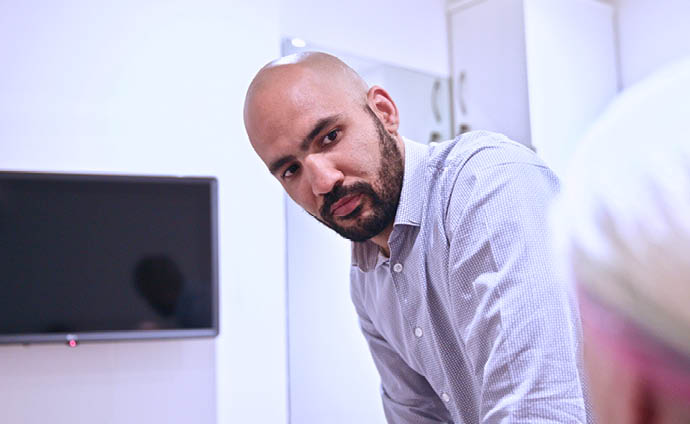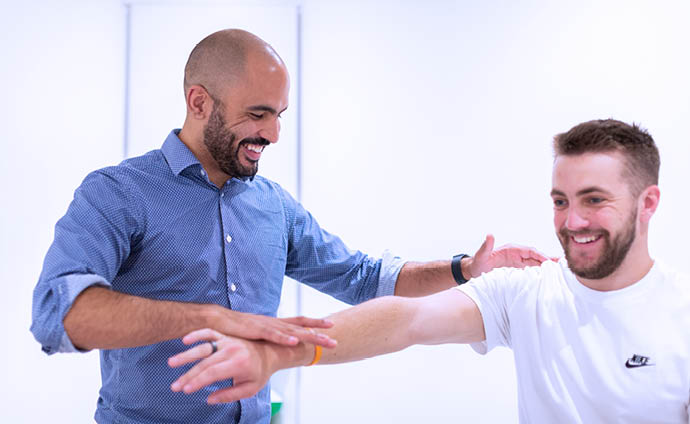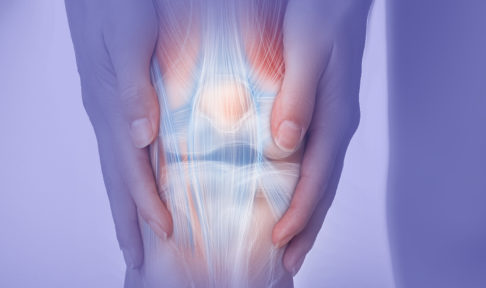Ant Brightwell is one of the Directors and Lead Physiotherapists at Spectrum’s London clinic. He is one of only five McKenzie Credentialed Therapists in London and he uses specialised techniques to treat and educate patients with back and neck pain, seeing impressively fast results.
This is a real case study from one of his recent patients, a mid-forties male with a 10-year history of back pain, cause unknown. The following words, written by Ant, will give you an insight into what it’s like being treated at Spectrum —from assessment right through to discharge.
I had a patient who came in with a history of back pain, with no clear reason as to why it first started 10 years ago. The first time it happened he treated it with a bit of bed rest and medication and it went away, so he kind of brushed it off. But then it started to become more frequent as the years went on, until this latest episode, which had been present for a couple of months before he came to see me. Again he ignored it at the start, then called his GP, had some medication and they put it down to muscle spasm and managed it. Until he started getting leg pain…
That was when he called Spectrum. It had gotten to the extent that the leg pain was what he recognised as sciatica. The pain was going all the way down his leg and was very mechanical in nature, so he was struggling with certain movements. Mornings were worse than the rest of the day — he had to almost ‘warm up’ into the day. When he bent forwards he couldn’t really stand up straight away, he’d get stuck halfway up and have to give himself a minute to get all the way up. So, he came in to see me.
The first thing I noticed was when he stood up in front of me, not only could he not get all the way upright, but he was also shifting off to one side. His upper body was actually standing crooked away from the site of his pain! His pain was going down his left leg and his upper body was shifting off to the right, because if he straightened up, the pain in his left leg increased.
We tested a couple of little things and confirmed that his nerve was definitely being pinched upon. My first treatment priority was to make sure he could stand straight and he wasn’t shifting off to that right. We did a load of McKenzie movements to focus on that first, which he didn’t find comfortable during the session. Essentially the technique was very technical, but when I do it, it kind of looks like I am almost rugby-tackling someone to help move their hips underneath their shoulders in certain positions. The patient didn’t like it as we were doing it because his back was in a bit of pain that he had to push through. But afterwards he stood upright and this improved his ability to bend and move in all directions, even though he still had the leg pain.

I got him to come back a couple of days later to repeat a similar treatment pattern and after doing that for about three or four sessions he was able to stand straight and that had already reduced the intensity of the pain in the leg. Yes, it was still going down the left leg and all the way down to the foot, but it wasn’t as sharp. And he was already noticing in the mornings that it was a bit easier to get up out of bed. While he still felt like he had to ‘warm himself up; for the day, it wasn’t as extreme. Now that we’d got him standing straight we were able to progress to more mainstream McKenzie moves and properly assess his back to try and get the pinch away from the nerve. We did a full-on McKenzie assessment and got him to do some extension mobilisations, (most people will know them as cobras, if you want to relate them to the yoga pose called cobra).
I have to be really clear here, if you are reading this and have back pain I do not recommend that you put your phone down and start doing cobras right now! This treatment was based on this specific patient’s condition off the back of a personalised assessment. A movement like a cobra is not a one-size-fits-all approach, and people with a sore back should never go blindly into a cobra because it’s not always the right thing to do. But in this case it was, so after the assessment he did 10 cobras up and down, and then we stood him back up and the pain in his leg was no longer reaching his foot. It was still down the leg, but not all the way down into his foot and he was able to bend forwards further before bringing on more pain.
So we sent him home with that as an exercise and told him to do it regularly throughout the day, almost hourly, because a lot of his postures throughout the day were, on a small level, harmful to his disc, loading or putting pressures in the wrong way. The aim was to break up his day as regularly as he could with an exercise that was helping him and taking the pressure away from the nerve, allowing the disc to heal. This helps speed up the healing process and increases the chance of a full recovery.

He came back four or five days later, and the pain was still in his leg but not even reaching his knee. I assessed him again and decided to keep him going down the cobra route, but to make the cobra more aggressive and more effective with certain technique changes, so he was happy with that. On top of this, we did some other treatment — we put him on TENS and I did a bit of hands-on massage and joint mobilisations. Once we were happy that the McKenzie moves were working, we started to very lightly activate his core within a safe range, to strengthen him up and help maintain the improvements that we were getting.
We sent him home again with those progressions and he came back the next week and we continued down this same pathway. It took three weeks for his leg pain to go away, which was not surprising given he’d had the pain for over two months prior to the first treatment. While we were happy the leg pain was finally gone, he was still getting mechanical pain through his back — every time he bent forward there was still a point where his back would start to hurt and that, for me, was a clear warning sign that we were close, but not quite done with this yet… his back was still showing signs of weakness.
We kept progressing the McKenzie as and where we could and we kept doing hands-on treatment. We also made his strengthening program more functional, getting him into standing positions, doing some squats and lunges with different resistance at certain angles, while asking him to make sure he still had control of his pelvis and his lower back positioning. It was slow but steady, but eventually we got him to the stage where he recovered full mobility through his back in all different directions. He was able to stand up straight without catching halfway, he was no longer shifting off to the right, and he had no leg pain. It was a full recovery.
At that stage we tentatively discharged him on the proviso that he needs to remember that the tissue is still healing on a biomechanical level, and while he doesn’t have pain it’s still vulnerable for another couple of months. I’ve told him to diligently continue to do the cobras at the level we discharged him at. I’ve not heard from him and it’s been about six months now, so I assume that’s a good sign and he’s made a full recovery!
If you’re suffering from back pain and would like a personalised assessment and treatment, contact Ant and the team at Spectrum to book an appointment today.



